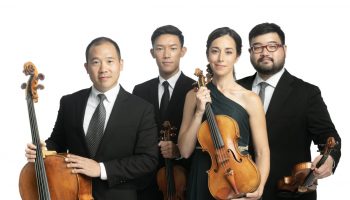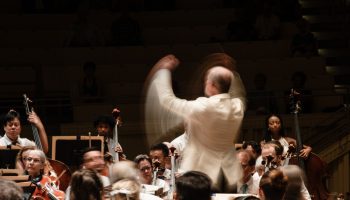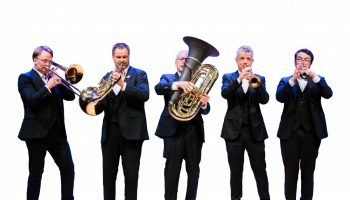
There is a time-honored tradition of art being used as a tool of resistance, and tonight the Chautauqua Symphony Orchestra will transport audiences to the political turbulence of the first Russian Revolution with a work that CSO violist Eva Stern described as a “disturbing” and “beautiful” artistic success.
Under Music Director and Principal Symphonic Conductor Rossen Milanov’s baton, the CSO will play Dmitri Shostakovich’s Symphony No. 11 — also known as “The Year 1905” — at 8:15 p.m. tonight in the Amphitheater.
Russian composer Shostakovich lived amidst political turmoil for most of his life; under a totalitarian regime, he was publicly denounced as a composer on several different occasions for “formalism,” meaning anything that was deemed critical of the state. His music is inextricably linked with politics.
Garnering worldwide acclaim at 19 years old with his First Symphony, Shostakovich continued creating revolutionary works of art that he was forced to self-censor for fear of retribution under Stalinist rule. Many of his symphonies, including his 11th, depict the frustration of living in constant danger, but outwit Stalin by taking on a tone of strictly enforced rejoicing.
“You see a lot of these very, very interesting works of art that on the surface seem to subscribe to the official ideology, but on the bottom, they actually always sound as a criticism or something superficial that represents the type of a regime and order under which they were living,” Milanov said. “So, there’s a lot of interesting parallels with the history of humanity.”
When Shostakovich created his 11th Symphony in 1957 post-Stalin, following the Soviet Union’s violent suppression of the Hungarian uprising in 1956, it was immediately publicly acclaimed yet privately controversial, and he faced criticism from authorities. A programmatic piece — meaning that the music tells a narrative — Shostakovich’s Symphony No. 11 depicts “Bloody Sunday” and the following 1905 Russian Revolution.
“I think that many things repeat themselves in Russian history,” Shostakovich wrote in his memoir Testimony. “Of course the same event can’t repeat itself exactly, there must be differences, but many things are repeated nevertheless. People think and act similarly in many things. I wanted to show this recurrence in the Eleventh Symphony. I wrote it in 1957 and it deals with contemporary themes even though it’s called ‘1905.’ It’s about the people, who have stopped believing because the cup of evil has run over.”
The first movement, “Palace Square,” sets a tense stage with anticipation of what’s to come; “The Ninth of January” details the actual massacre of more than 200 peaceful protestors; “Eternal Memory” is a contemplative memoriam for the people who died; and “Tocsin” is a call to action of the revolutionary spirit. Gun shots are expressed with the snare drum, while the bass drum and timpani represent explosions, violist Cynthia Frank said.
“It’s really the sound of a revolution. People describe it as a film score without a film because it’s so cinematic,” Frank said. “When you hear it, you will envision what is happening.”
The piece is a mental workout due to the technically challenging, unexpected and speedy patterns, Stern said. Since violas usually play in a lower range, Frank finds that the difficulty arises as the register continuously ascends to a deafening level.
Drawing from melodies in “revolutionary songs,” Shostakovich wove them in and out of the composition, which adds a whole other level of complexity, Milanov said. Born in Bulgaria, Milanov spent 25 years living under communist regime and was taught these “revolutionary songs” as a kind of brainwashing.
“Shostakovich evokes musical memories by bringing something that is familiar, sometimes completely trivial, sometimes really profound. It’s interesting how music could do so many different things, but mostly (it’s) an interplay of what is present and what is memory. For people that have never heard this piece, it’s one of the most cinematographic and bombastic works — it’s going to be impressive,” Milanov said. “It’s going to be physically felt by everyone in the audience. I do believe, having done probably most of his important works, that the physical sensation of violence in the audience by the music was very important to him to translate the actual violence that people were experiencing in their real life.”
Now in her 33rd year with the CSO, Frank finds that this piece is deeply relevant, especially considering that Chautauquans are heading into the Week Six theme of “The Global Rise of Authoritarianism.”
“This piece is really about the danger of unchecked power and what can happen, does happen and has happened,” Frank said. “It’s very telling of the moment repeating itself.”
Milanov draws comparisons between the similarities between The Great Purge, which had widespread disappearances of the Soviet Union’s political opponents, and events in the United States of individuals wearing masks deciding who does not belong, without justification.
Stern feels that when learning history isn’t enough to stop ourselves from repeating it, music can bridge that gap of empathy.
Mediums like music are important in that they “can really put us into the feeling of what that feels like to be suppressed, or to be living in a violent government or have loved ones in any sort of trouble,” Stern said. “We all need anything that kind of helps us be awake. A piece of music like this is just so powerful in that way.”




